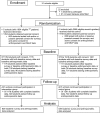Two-Year BMI Outcomes From a School-Based Intervention for Nutrition and Exercise: A Randomized Trial
- PMID: 27244788
- PMCID: PMC4845865
- DOI: 10.1542/peds.2015-2493
Two-Year BMI Outcomes From a School-Based Intervention for Nutrition and Exercise: A Randomized Trial
Abstract
Objectives: This study examined the long-term effects on BMI of a randomized controlled trial of Students for Nutrition and Exercise, a 5-week, middle school-based obesity prevention intervention combining school-wide environmental changes, encouragement to eat healthy school cafeteria foods, and peer-led education and marketing.
Methods: We randomly selected schools from the Los Angeles Unified School District and assigned 5 to the intervention group and 5 to a wait-list control group. Of the 4022 seventh-graders across schools, a total of 1368 students had their height and weight assessed at baseline and 2 years' postintervention.
Results: A multivariable linear regression was used to predict BMI percentile at ninth grade by using BMI percentile at seventh grade, school indicators, and sociodemographic characteristics (child gender, age, Latino race/ethnicity, US-born status, and National School Lunch Program eligibility [as a proxy for low-income status]). Although the Students for Nutrition and Exercise intervention did not exhibit significant effects on BMI percentile overall, intervention students who were classified as obese at baseline (in seventh grade) showed significant reductions in BMI percentile in ninth grade (b = -2.33 percentiles; SE, 0.83; P = .005) compared with control students. This outcome translated into ∼9 pounds (∼4.1 kg) lower expected body weight after 2 years for an obese student in the intervention school at the mean height and age of the sample at baseline.
Conclusions: Multilevel school-based interventions can have long-term effects on BMI among students who are obese. Future research should examine the mechanisms by which school-based obesity interventions can affect BMI over time.
Copyright © 2016 by the American Academy of Pediatrics.
Conflict of interest statement
Figures
References
-
- Skinner AC, Skelton JA. Prevalence and trends in obesity and severe obesity among children in the United States, 1999-2012. JAMA Pediatr. 2014;168(6):561–566 - PubMed
-
- Whitaker RC, Wright JA, Pepe MS, Seidel KD, Dietz WH. Predicting obesity in young adulthood from childhood and parental obesity. N Engl J Med. 1997;337(13):869–873 - PubMed
-
- Wang Y, Wu Y, Wilson RF, et al. . Childhood Obesity Prevention Programs: Comparative Effectiveness Review and Meta-Analysis Review No. 115. Rockville, MD: Agency for Healthcare Research and Quality; 2013 - PubMed
Publication types
MeSH terms
Grants and funding
LinkOut - more resources
Full Text Sources
Other Literature Sources
Medical


